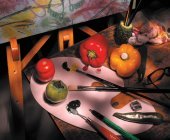|
Digital Photography TipsDigital photography tips on depth of fieldThis tip is mainly useful in outdoor child photography, outdoor portraits and birds photography. This tip is also useful in wild life photography. We require a shallow depth of field to blur distracting background, when shooting all these subjects, so that the sharply focused main subject stands out in the photograph. For this, we have to use a wide aperture. As we know the fact, that depth of field in photography depends on the aperture and apart from the aperture, there are other two considerations for depth of field. Those are distance between the camera and the subject and focal length of the lens. In child, portrait and birds photography, a lens with longer focal length is used, which is generally about or more than 200 mm on 35 mm film format. Use of a lens with longer focal length will reduce the depth of field. If the distance is less, the depth of field is further reduced. So by adding all factors, the resulted depth of field is reduce to few (two to five) centimeters (one to two inches)when we use the widest aperture on the lens. In such case, we will not be able to get just enough depth of field, which will keep the main subject sharp. Nose of a person will be focused but cheeks and ears will go out of focus and blurred. So how can we be sure that we have just enough depth of field? Well, instead of shooting at the widest aperture, (which can be f 2.8 or f 4), we should use f 8 or f 11 or f 16. Now the question is, which one? We can be sure for the focus on main subject, when we use f 16, but at the same time, the background is not pleasingly out of focus. If we open up the aperture, we may over correct the image for the background and with less depth of field, the result is not having just enough depth of field. So we must create a balance, which is just enough.
This digital photography tips shows you how to deal with aperture in these circumstances. The prime concern is the distance and we have to select the correct aperture for the given distance between the subject and the camera to get just enough depth of field. Here is a simple formula, which can be applied to find the aperture, which will give us just enough depth of field. focal length of the lens (in mm) / distance (in decimeters) = required aperture Let us take an example. Say the lens we are using is of 300 mm and the subject is 2.7 meters away. 2.7 meters = 27 decimeters (metric conversion) So, 300 / 27 = 11.11 This means that the required aperture for just enough depth of field is f 11 Instead of 300 mm lens, if we are using 200 mm lens and subject is at a distance of 2.5 meters, then, 200 / 25 = 8 This means that the required aperture for just enough depth of field is f 8 Get some more digital photography tips on different genre of photography
Read more about various subjects of photography How to become a professional photographer Photography in direct sun light Royalty free stock photography
Return back to Home Page from Digital photography tips
|






